______ _ __ _ __
/ ____/___ _________ ____ __ _| | / /___ (_)___/ /
/ /_ / __ \/ ___/ __ \/ __ `/ |/_/ | / / __ \/ / __ /
/ __/ / /_/ / / / / / / /_/ /> < | |/ / /_/ / / /_/ /
/_/ \____/_/ /_/ /_/\__,_/_/|_| |___/\____/_/\__,_/
The Gear of Fornax Void
Document created: 2020-SEP-14
Last document update: 2024-Nov-24, 08:52
A list of Hardware, that at some point has been part of the Fornax Void studio — or still is.
I added some personal notes to each piece of gear. These notes are by no means professional, in-depth reviews, but rather a roundup of subjectuve experiences and some occasional behind-the-scenes information regarding my projects.
Also check the Cyberspace Database Project Documentation for more information about the audio gear used on Cyberspace Database as well as a complete synthesizer-per-track utilization list.

Table of contents:
Synthesizers
Workstations
Cameras
SYNTHESIZERS

ROLAND JV-2080
One of my all-time favorites, the JV-2080 comes with 16 part multitimbrality, 64 note polyphony, 4 waveform oscillatros per note and some of my absolute favorite Pad waveforms. With it's huge, bright display and well designed user interface it's very easy to program and also has quite some handy tricks up it's sleeve.
The JV-2080 was used extensively on
Cyberspace Database and was a defining force in the creation of the Fornax Void sound and SemiconductorWave genre. Many important tracks like 'Borlando Loom', 'Cyberspace Database' or 'Ramen Multinode' consist mainly of sounds from the 2080. You can find out more about what synths were used on what tracks of Cyberspace Database in the
CSDB Production Notes.
My upcoming album 'Music for dystopian concrete buildings' was almost exclusively recorded with the Roland JV-2080.


ROLAND JV-1080
Almost the same as the JV-2080 but with a slightly different sound and much smaller, non-graphical display. For detailed information about the differences between the Roland JD/JV/XV synths, check Don Solaris'
'Ultimate Roland JV, JD, XV F.A.Q.'
The JV-1080 was used on
Cyberspace Database to record most of 'Yoshimura's Journey' as well as all the sounds of 'The Lost Archives' and the sample used to track 'Nankyoku Data Hive'.

OBERHEIM XPANDER
Once called the most flexible non-modular synthesizer ever made, the Oberheim Xpander comes with lots of oscillators, filters, lfos, envelopes and even more routing possibilities. Its a bit like having an analog modular synth in a box. The Xpander was one of my first synths, and figuring out how to patch it, helped me a lot understanding synth theory.
With the exception of some effect sounds, the patches I made and used with the Xpander were - contraty to the device's abilities - often very simple. I really like the raw sound of the oscillators with just a bit of vibrato and a long release time as heard on
Cyberspace Database on tracks like 'Oberheim Taxi / Shanghai Xpander', 'Ancient Data Tapes' or 'Server Room Love Letters'.
Between 2014 and 2018 the Xpander was one of my most used synthesizers, but I put it up for sale in early 2019, during the mixing and mastering process of
Cyberspace Database to finance the physical release and get rid of the risk of owning such an expensive and rather vintage device.

KORG WAVESTATION A/D
A very interesting synth. Initially a bit weird to program because of it's unique architecture and unorthodox naming conventions, the Wavestation A/D is quite a nice piece of gear. Beneath the one of a kind synth engine I also highly appreciate the XLR outputs on the A/D model.
On
Cyberspace Database the Wavestation A/D play the main protagonist on the tracks 'Cyborg Samurai Miyamoto' and 'Soyokaze Suteshon 199X'. Unlike with the Korg M1, the WaveStation A/D sounds a lot better than it's plugin counterpart.

KORG M1R
The Korg M1R brings a lot of digital bliss to the table. While the WaveStation hardware iteration sounds a lot better than the plugin, the M1 legacy plugin is one of the few plugin version of a synth I prefer over the real hardware. Not only does the plugin sound very close to the real thing - be it probably slightly cleaner and with more presence - it also comes with all the PCM cards, you'd be paying a fortune and searching for years to get them all. Also the plugin has some functions the M1 hardware does not, and has a really nice patch library.
Nontheless the M1R hardware found it's way on quite a few tracks on
Cyberspace Database. It plays an important role on 'Offshore Network Vertex' and can also be heard on 'Cyborg Samurai Miyamoto', 'SysAdmin Coffee Break Saga' and the Void Gate Duology. For comparison, the M1 plugin is the main protagonist of the tracks 'A Cubicle Tale', 'Dreams of the Void', 'Traversing the Nodes' and 'Sempiternal Night Shift'. It's also an integral part of the sounds on 'Corporate Intranet Menu Music'.
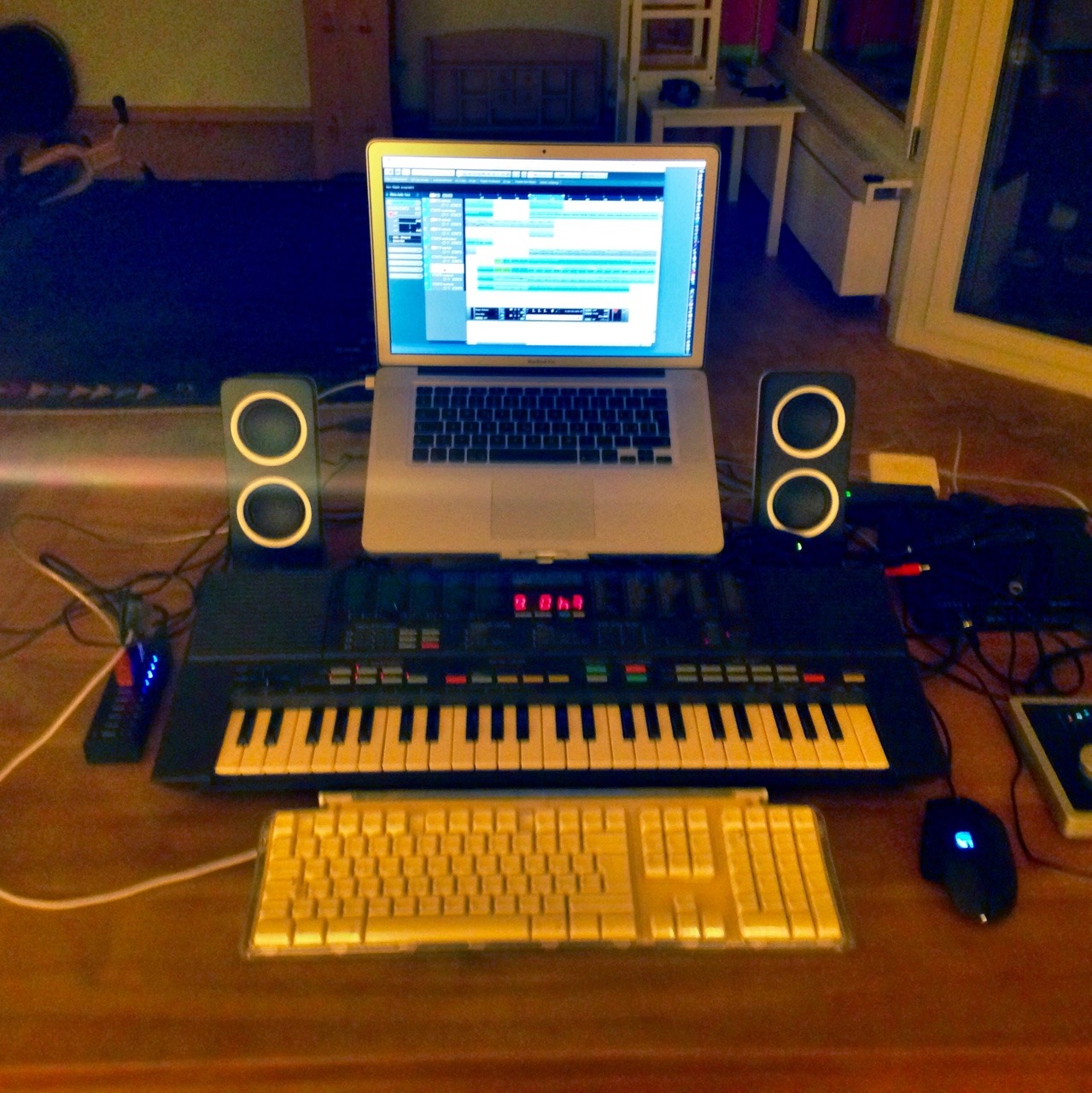
YAMAHA PSS-480
The PSS-480 is a programmable 2-OP FM synthesizer with MIDI and was the very first synthesizer I owned as a kid. I still have memories of me and my Dad, connecting this thing to my PC with a MIDI to GamePort cable. I also used to do my own patches as a kid, without having too much of an idea what I was doing. This shows that the programming is so easily accessible that you'll start intuitively start changing patch parameters when just playing around on the interface - which I dare to say is very atypical for Yamaha FM synths of the time.
As the original device I own since my childhood generates a humming sound on the audio output since I first owned it back in the early 90s, I bought a second one in June 2016.
With the setup shown on the image on the left, I recorded the tracks 'Remembering Johny Castaway' and 'Cyberspace Druids'. I also used the PSS-480 for many crackling drone sounnds on 'Void Gate Access Software', 'Void Gate Panorama Station' and 'Offshore Network Vertex'.

KORG POLY 800 MK2
The 2nd synthesizer I ever owned - found for just CHF 30 (~USD 30) in a thriftstore, half the price of some relatively uninteresting keyboards laying right next to it. While I never really got into programming my own patches on it until years later, this device was important for me as a first step into recording music with hardware synthesizers.
I used the Poly 800 quite regularly when recording soundtracks for my projects during my time at film school (2009-2012). My 2016 mini-album
Tomes of Erebus was almost exlusively recorded with the Poly 800 MK2, directly onto a Tascam Portastudio 414 mk2 4-track tape recorder without the use of a sequencer.
While the device had some importance in my musical developent history, I never really appreciated it's sound too much and put it up for sale in early 2019 to raise money for the
Cyberspace Database physical release.

ARTURIA MINIBRUTE
When I first tried the Minibrute in a music store, I very much disliked it. Years later I bought it anyway, to complement my sound palette with something that was able to create more aggressive sounds than my other synths.
It can be heard on
Cyberspace Database on 'Offshore Network Vertex' and on the Void Gate Duology (sometimes with so much reverb it started to sound like orchestral strings). It also plays parts on 'Hexadecimal Love Letters' and 'Voidnet Online Service Provider'. All tracks of the Void Wizards Saga were completely made with my
Minibrute Sample pack.
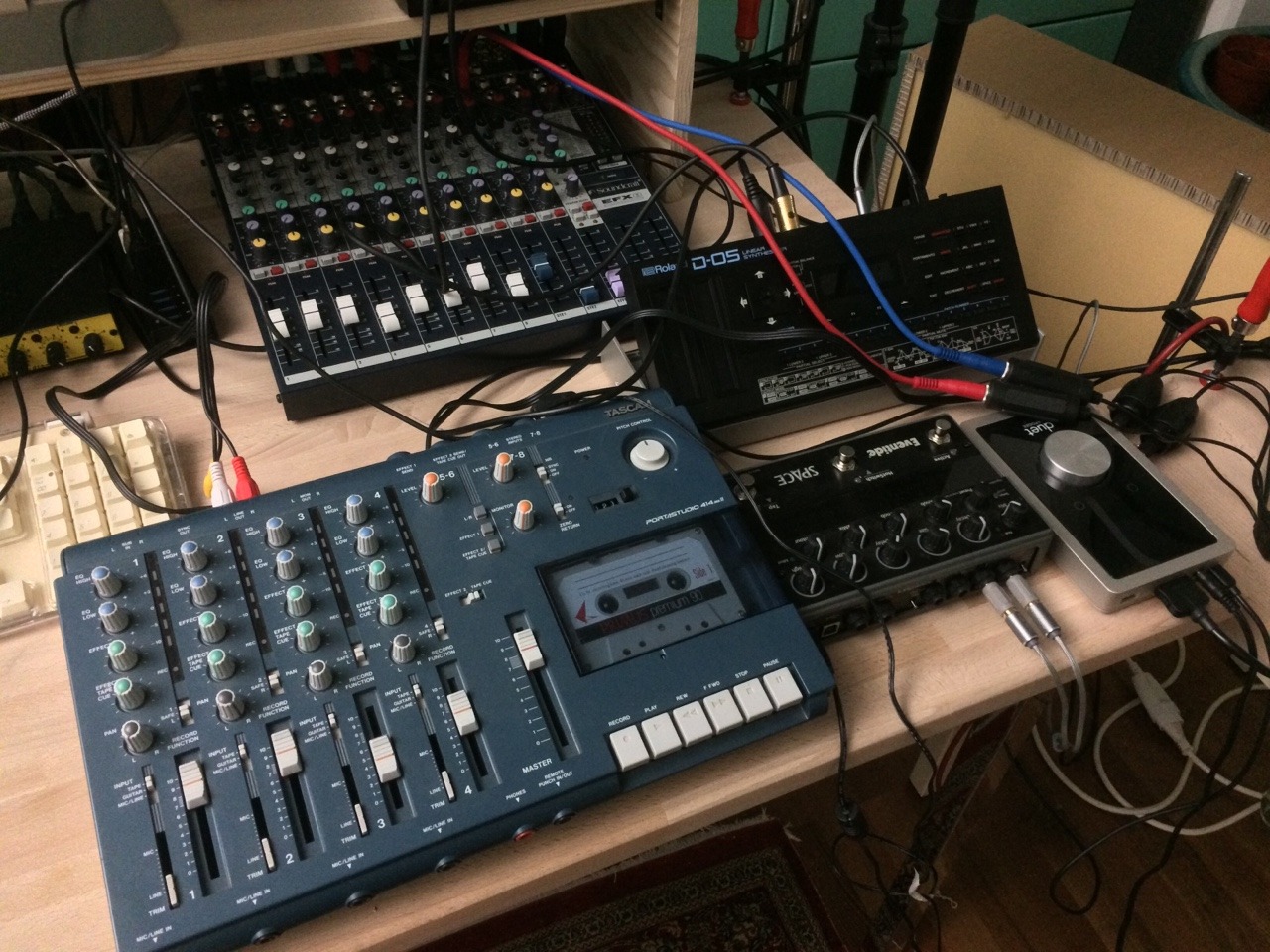
ROLAND D-05
The D-05 is a reissue of the famous Roland D-50. The architecture reminded me a lot the Yamaha TG-33 which might have been an answer to Roland's success with the D-50.
I used the D-05 on a couple of tracks: 'Super Aliasing' was exclusively recorded with the D-05, my portastudio 4-track and the Eventide Space (the picture on the left shows my setup while recording this track). I also used the D-05 on 'Offshore Network Vertex' and the 'Void Gate' duology.
While I liked it's sound capabilities, I never was particularly fond of it's form factor and it's measly 3,5mm output jacks. I sold the device in early 2019 - arguably a few months too early as it got discontinued soon after and 2nd hand prices of the D-05 skyrocketet far above it's original price.

AKAI S1000
While it might not be as grainy as pre-16-bit samplers like the S900 or the Ensoniq Mirage, the S1000 still has a unique coarse sound — maybe due to it's vintage 16-bit A/D D/A coverters. In 22kHz mode it hits a sweetspot somewhere between lofi and CD quality.
The S1000 is featured most prominent on the
Cyberspace Database track 'SysAdmin Coffee Break Saga', where it multitimbrally plays many of the instruments. All samples were sourced from other synths in my studio to make use of the sound of the S1000's A/D coversion.
I like to use the S1000 without SD card adapters with floppy disks as storage device. It adds a certain charming slowness to the process. I'm planning to replace the old display on my S1000 though, as it is hardly readable anymore.
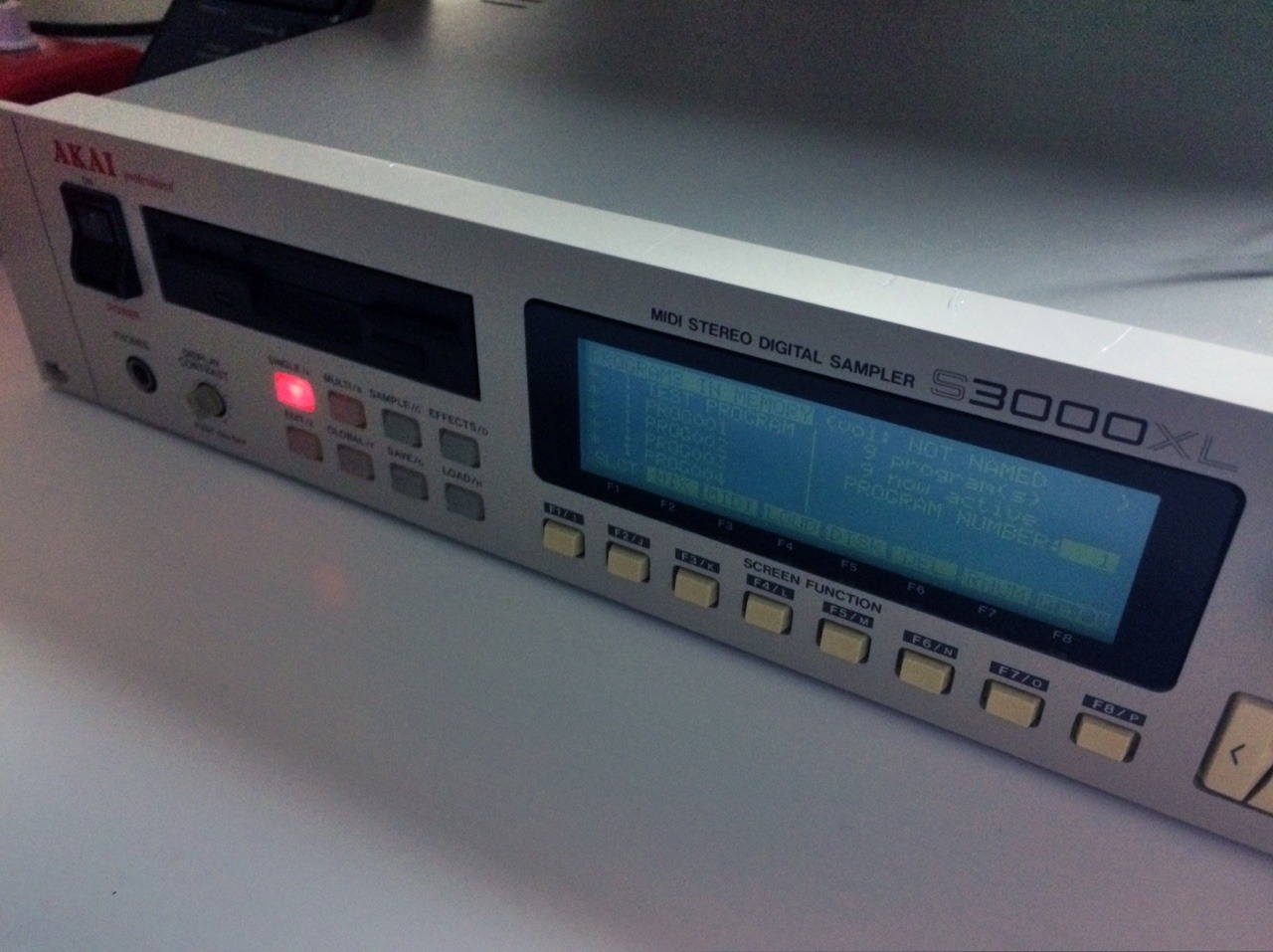
AKAI S3000XL
Very similar to the S1000 but with a smaller form factor, double the polyphony and optionally with more RAM but without the XLR inputs.
On
Cyberspace Database, I only used the S3000XL on the Void Gate Duology, as in my opinion the S1000 sounds a bit more crispy to my ears. What I prefer about the S3000XL is the smaller form factor and sleaker design. It also feels more sturdy (with exception of the data wheel) with better buttons and a much better power button. The Power button on the S1000 is squishy and sometimes fails to do it's job.
While I prefer almost everything about the S3000XL over the S1000, including the sleak medical-device looking 90s design, the S1000 just sounds a tad more crunchy to me.

ROLAND TR-505
This 1986 drum machine features 16 drum and percussion samples in 8-bit 25 kHz quality. I borrowed this thing from my brother-in-law, in the late 90s, and it's still laying around in my studio.
I haven't used this device much on
Cyberspace Database, but there are some sounds of it on 'Hexadecimal Love Letters'. Its also featured on 'Offshore Network Vertex' as noise effect with a ton of reverb from the eventide space.
Its not something particularly special these days, but it still has a special place in my mind, as it was one of the first electronic music devices and the first hardware sequencer I ever got my hands on.
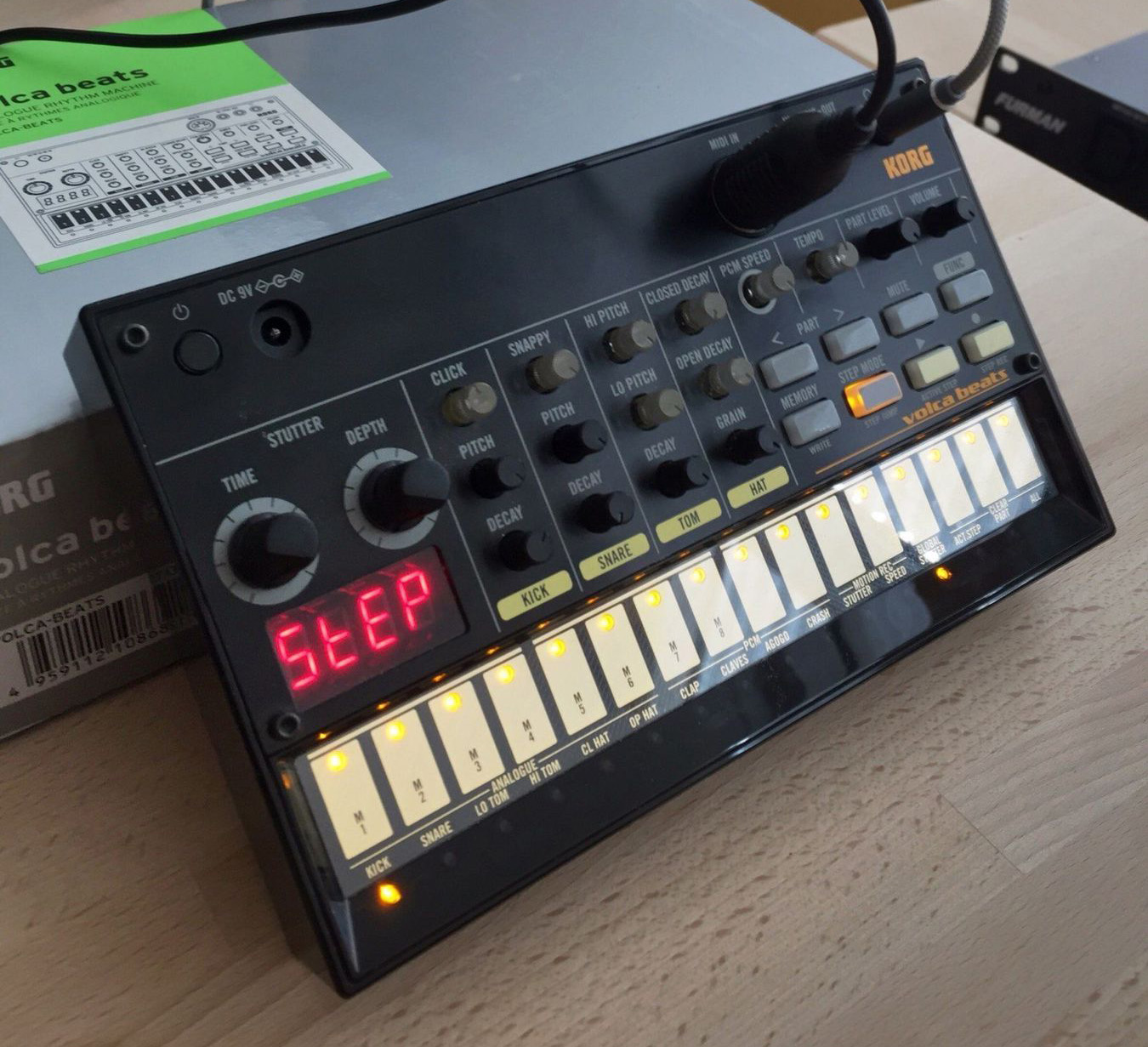
KORG VOLCA BEATS
A pretty nice little drum machine with analog and PCM sounds and hands on potentiometers for all parameters. Probably the most drum machine per money-unit you can get.
Used on
Cyberspace Database on the track 'Offshore Network Vertex'.
While it is a nice device, the Korg Volca Beats was one of the units I sold to finance the
Cyberspace Database physical release. It made liquidation list because I rarely use drums in my tracks, I prefer using samplers as percussion sources, the Roland JVs also have a ton of percussion sounds and I highly disliked it's mini-jack audio output.

C64 + MSSIAH
Back in 2012, I got myself 4 C64 computers. Two old ones with 6581 SID chips and two C64C models with 8580 SID chips, plus 4 MSSIAH cartridges. Those MSSIAH cartridges are absolutely genius. You got MIDI input, and a bunch of software to programm voices, use the SID in 3x multitimbral or 3x polyphonic mode (or everything in between) as well as the option to use it as a primitive sampler.
I used the SID (both versions) a couple of times on
Cyberspace Database. It's especially prominent on Offshore Network Vertex, Hexadecimal Love Letters and Void Gate Access Software. The SID can sound really intense and big.
You can hear a couple of track recorded with the setup seen on the pciture on the right on my
SoundCloud (4*C64 with MSSIAH + 1*NES with WayFar MidiNES).

WAYFAR MIDINES
I happily was able to purchase this now exceptionally rare device for a back in 2012. It can multitimbrally access all the NES' channels (pulse, pulse, triangle, noise) plus a sample channel with a ton of lofi samples sources from many famous drum machines and such. This makes the MidiNES a great 8-bit drum rompler, which might arguably be the coolest thing anout this device.
I used the MidiNES on
Cyberspace Database on the tracks 'Void Gate Access Software' and 'Void Gate Panorama Station'.

RECKLESS EXPERIMENTATION AUDIO LLC YM3812
Probably my favorite FM synth, this little device incorporates the Yamaha YM3812 chip, also known as OPL2 - the same chip as used on the famous AdLib sound card, the Sound Blaster 1.0 and the original Pro AudioSpectrum from 1991.
With it's MIDI-in this box makes the YM3812 easily accessible. There is lots of different multitimbral modes with all parameters fully accessible directly on the device.
The track 'Topographic Multiplexer' on
Cyberspace Database was entirely made with the YM3812 and it was also used on the Void Gate Duology.
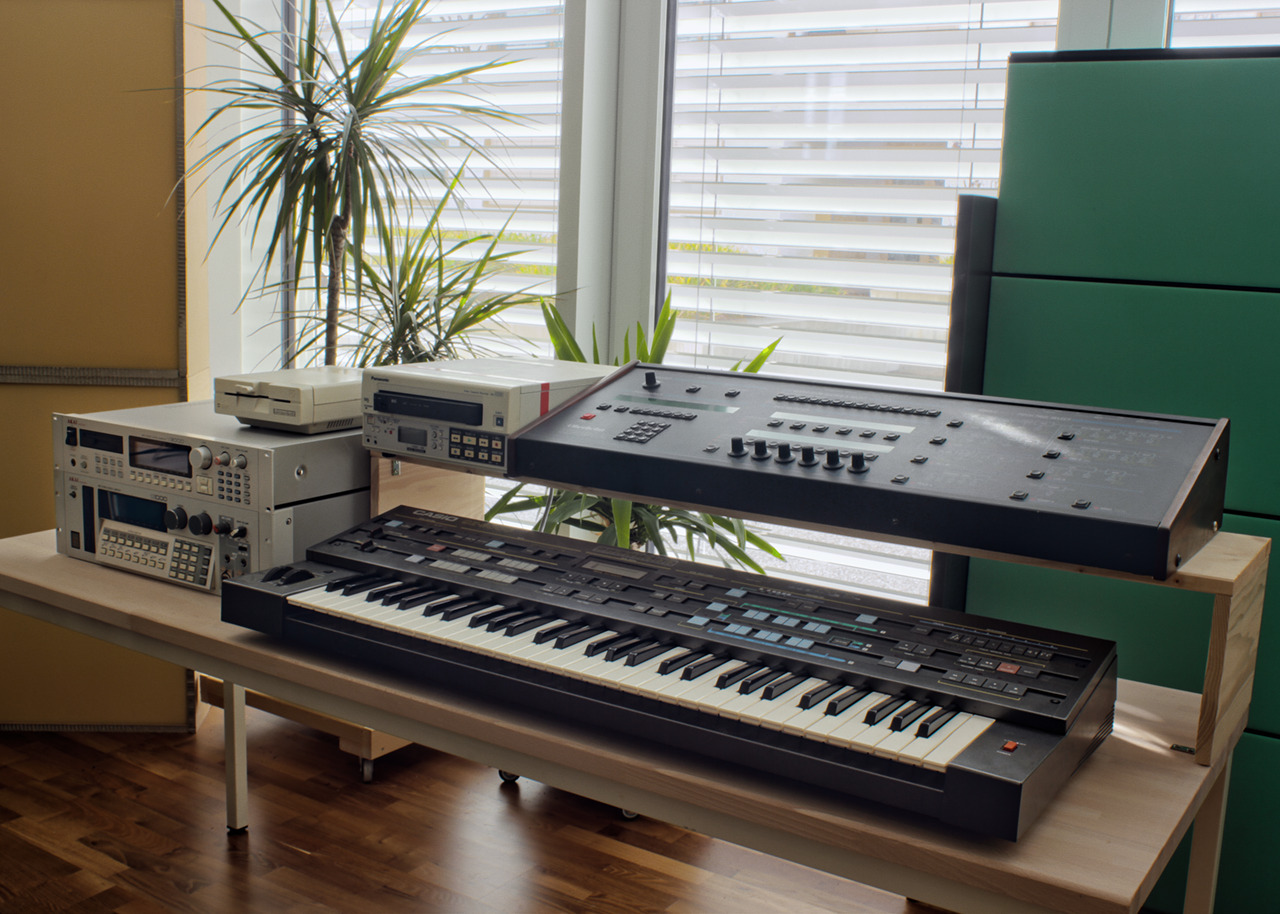
CASIO CZ-5000
Capable of some great sounds, the CZ-5000 can be heard on
Cyberspace Database as the lead sound on 'SysAdmin Coffee Break Saga'.
The 8-step envelopes can create some very slowly evolving sounds. The sound character bears some similarity to Yamaha's DX line of synths.
While I like it's sound character and the integrated chorus, I never got particularly warm with the creaking plastic buttons on this synth. Because of this and the fact that I didn't use much more than one self-made patch as well as the huge behemoth form-factor, the CZ-5000 ended up being one of the synths that I sold to finance the physical release of
Cyberspace Database. If I ever feel the urge to go back to the CZ sound, I will try to find the much smaller CZ-101.
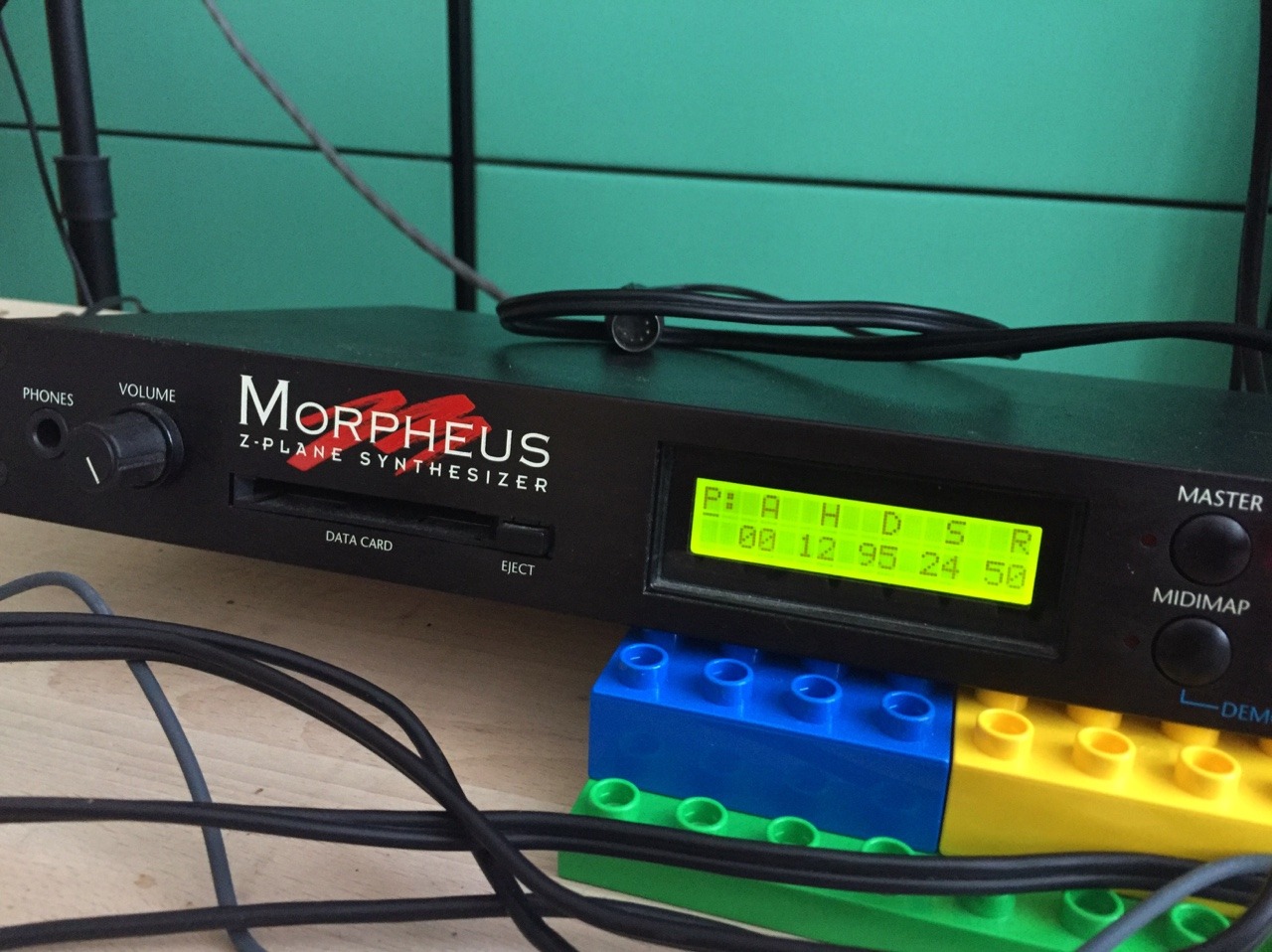
E-MU MORPHEUS
I got this interesting vintage digital synthesizer towards the end of the
Cyberspace Database production process. I haven't found much time to delve deep into it's functionality, but from what I can tell so far, it is not as complicated to program as the small display suggests. Nontheless the patches have a ton of parameters and the Morpheus' sonic capabilities are quite expansive.
As I was already far into mastering the album, this synth hasn't got much action on
Cyberspace Database. I've done some percussion elements on 'Corporate Intranet Menu Music' with it, as well as the re-recorded lead sound on 'Proterozoic Ocean'.
Can't wait to spend more time with this synth, to learn more about it's architecture.

ROLAND U-110
The U-110 is a very basic ROMpler with very few editable parameters. Not the most exciting device but it has a couple of ok sounds in it's library. Also, if you like cheesy late-80s fretless and slap bass rompler sounds you're covered. With it's dark case, green display and blue font it visually fits right in with Roland's 90s rack module design language. There are also about fifteen cards you can get to upgrade it's sample rom of which you can equip 4 simultaneously.
On
Cyberspace Database the track 'PCM Sound Module U-110' was entirely made with sounds from the U-110, although not using the device itself, but the
Roland U-110 Sample Pack I made. I also used the U-110 natively on 'Offshore Network Vertex'.
I didn't keep this device for long and I woulnd't say its worth the prices its going for today, but if you run into one for under 50€ you might wanna get it for the approximately one or two sounds on it you'll like and sell it later.

YAMAHA REFACE CS
Initially got this with the naive idea to compose tracks with it at home, to later translate them to the Oberheim Xpander at the studio. Didn't quite work out that way.
Found it's way on a couple of tracks on
Cyberspace Database: 'Offshore Network Vertex', the Void Gate Duology and 'Hexadecimal Love Letters' - but never really managed to occupy any prominent positions. Like many VAs it just sounds a bit thin.
Unlike other more recent small synths, it has two proper 6.3 mm jacks for stereo output, which is a big plus in my book. It also has MIDI in and out with a breakout cable, although I usually just hooked it up via USB. The build quality is solid. After all it still didn't survive decluttering in early 2019.
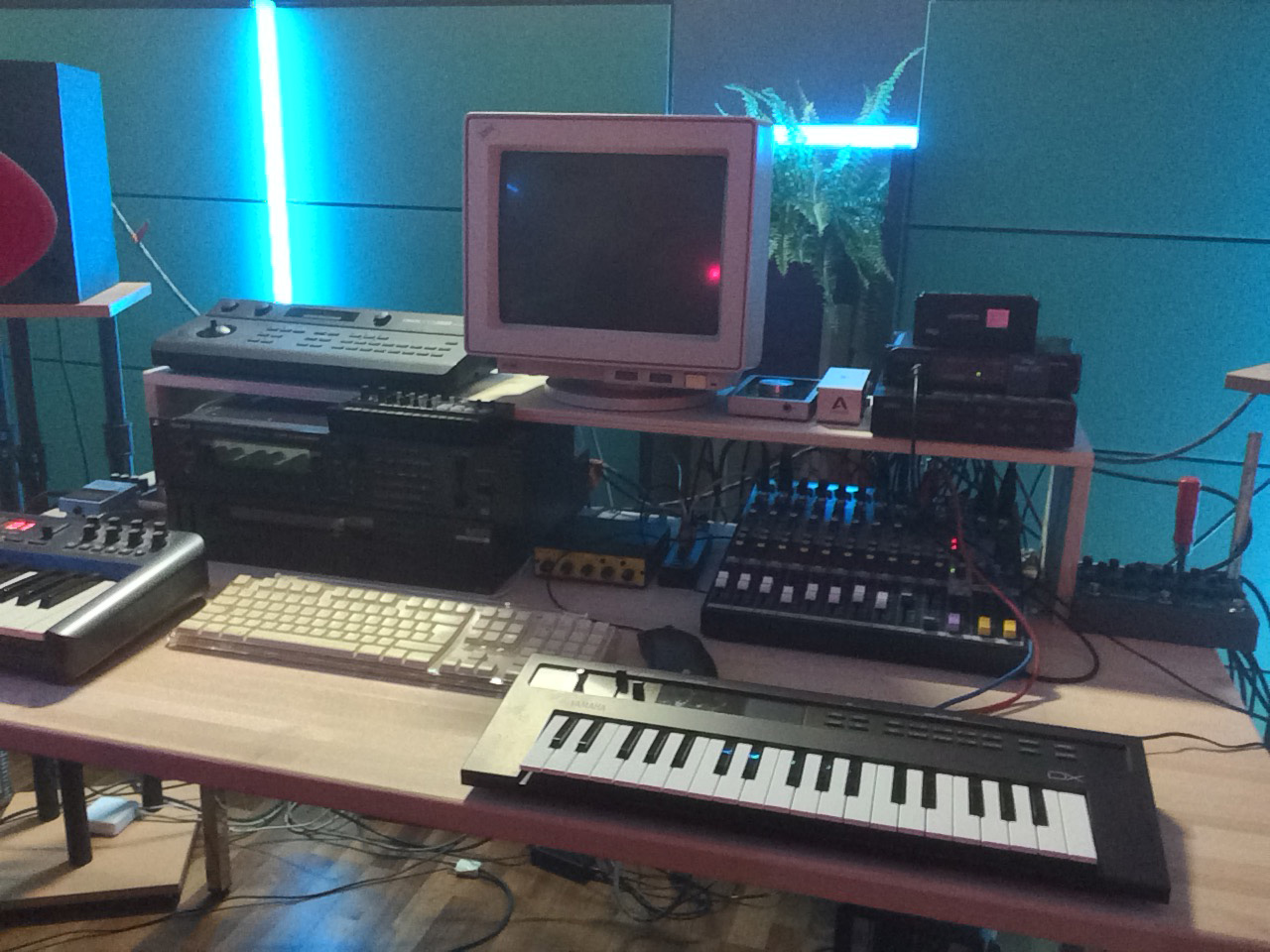
YAMAHA REFACE DX
After 30 years Yamaha finally did it and created a very easy to program, pretty hands-on 4-OP FM synth.
I used the Reface DX on
Cyberspace Database on the track 'Offshore Network Vertex' and on the Void Gate Duology.
While I quite liked the accessibility of the FM engine on the Reface DX, I wasn't very fond of the touch screen interface - while its pretty decent for what it is. The main thing that made me sell this synth though, was that its rather on the soft side for an FM synth. Gorwing up with the Sound Blaster 16 (OPL3), I also just generally prefer 2-OP FM synths over 4-OP or higher.

WALDORF ROCKET
The relatively inexpensive Rocket isn't a device I'd recommend to many people, but I was still glad to have it back during the
Cyberspace Database era. Not particularly great sounding as a main synth, the Rocket is pretty versatile for effect work.
Its a pretty good device to create short subtle percussion sounds with it as heard on 'Hexadecimal Love Letters' and 'Illustrated History of Nature'. It's also great to filter external mono signals, in combination with the LFO can also be used as tremolo - as heard on 'Void Gate Panorama Station'.
Not the greatest synth but a nice effect box. Midi implementation is pretty good but sadly it can't send arpeggiator data as MIDI notes via USB. Sold this thing at some point, but wouldn't mind getting another one someday as LFO filter box.

ROLAND TB-03
While I can't compare the TB-03 to it's ridiculously expensive and sought after original (or any of it's analog clones), this virtual analog reissue sounded quite good to me. But then, I also used this thing not how most people who search for a TB-303 clone will use it.
It can be heard on
Cyberspace Database during the end of 'Void Gate Access Software' as some kind of harp or guitar like instrument as well as on 'SysAdmin Coffee Break Saga'.

YAMAHA DX21
The DX21 is a 4-OP FM synth from Yamaha's original line. Its a good sounding FM synth and has a quite solid keyboard and overall build quality.
Together with the FB-01 this was one of the two synths used to record the
Cyberspace Database tracks 'Wintermute' and 'Life Simulator'. It can also be heard on 'SysAdmin Coffee Break Saga', the Void Gate Duology, 'Hexadecimal Love Letters', 'Personal System/2' and 'Voidnet Online Service Provider'.
The DX21 is very annoying to program. You can tell the user interface was developed with budget restraints in mind. Things often feel way more complicated than they could have been. I sold the DX21 in early 2019. In hindsight I'd probably go for the DX100.

YAMAHA FB-01
An interesting multitimbral FM synth. I think you need an external editor to program it - at least thats what I did to create the few patches I made on this thing. Not a very accessible synth but I always liked the coarse sound and the case design with the red display.
Together with the DX21 this was one of the two synths used to record the
Cyberspace Database tracks 'Wintermute' and 'Life Simulator'.

YAMAHA TG33
The basic architecture of the TG33 reminded me a bit of the Roland D-50, or on the D-05 I owned respectively. But Yamaha did it once again and made a device thats kinda hard to program - the D-05 is much more accessible. While the TG33 is able to produce some really nice sounds, I was never really getting warm with it - one of the downsides of gear acquisition syndrome is that you might start to neglect less accessible synths.
The TG33 can be heard on
Cyberspace Database tracks 'Offshore Network Vertex', 'SysAdmin Coffee Break Saga' and the Void Gate Duology.
The TG33 was one of the synths I sold to finance the
Cyberspace Database physical release. Maybe I'll revisit this device someday.
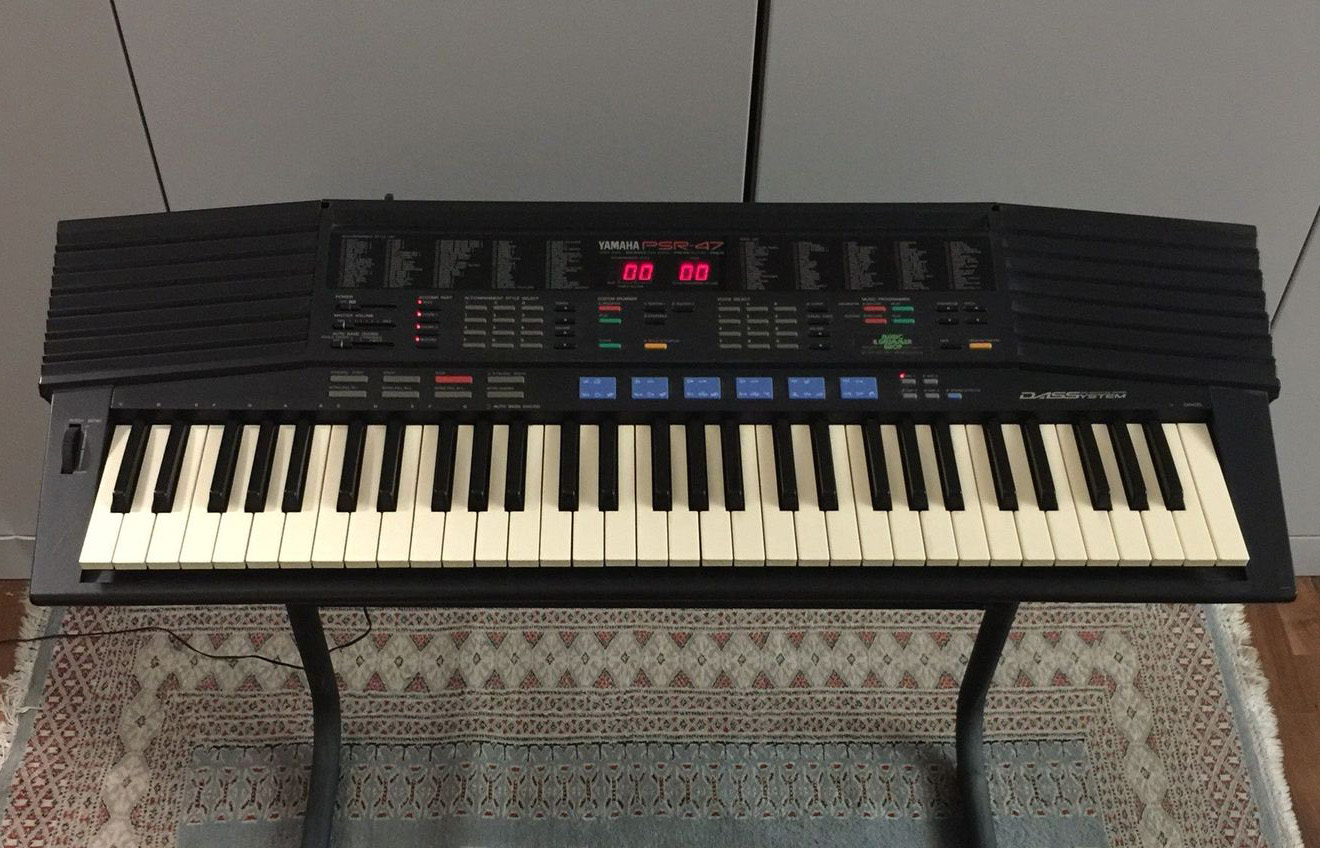
YAMAHA PSR-47
A non-programmable but nontheless somewhat interesting Yamaha keyboard with FM engine and lots of presets - some of them quite nice. It also has MIDI. I found this at a thrift store and couldn't resist.
The
Cyberspace Database tracks 'Defragmentation Process' and 'Screensaver Library' were completely made with the PSR-47 and it can also be heard on the Void Gate Duology.
I sold this thing in early 2019, as its pretty big for what it does, but I still had a fun time with it.
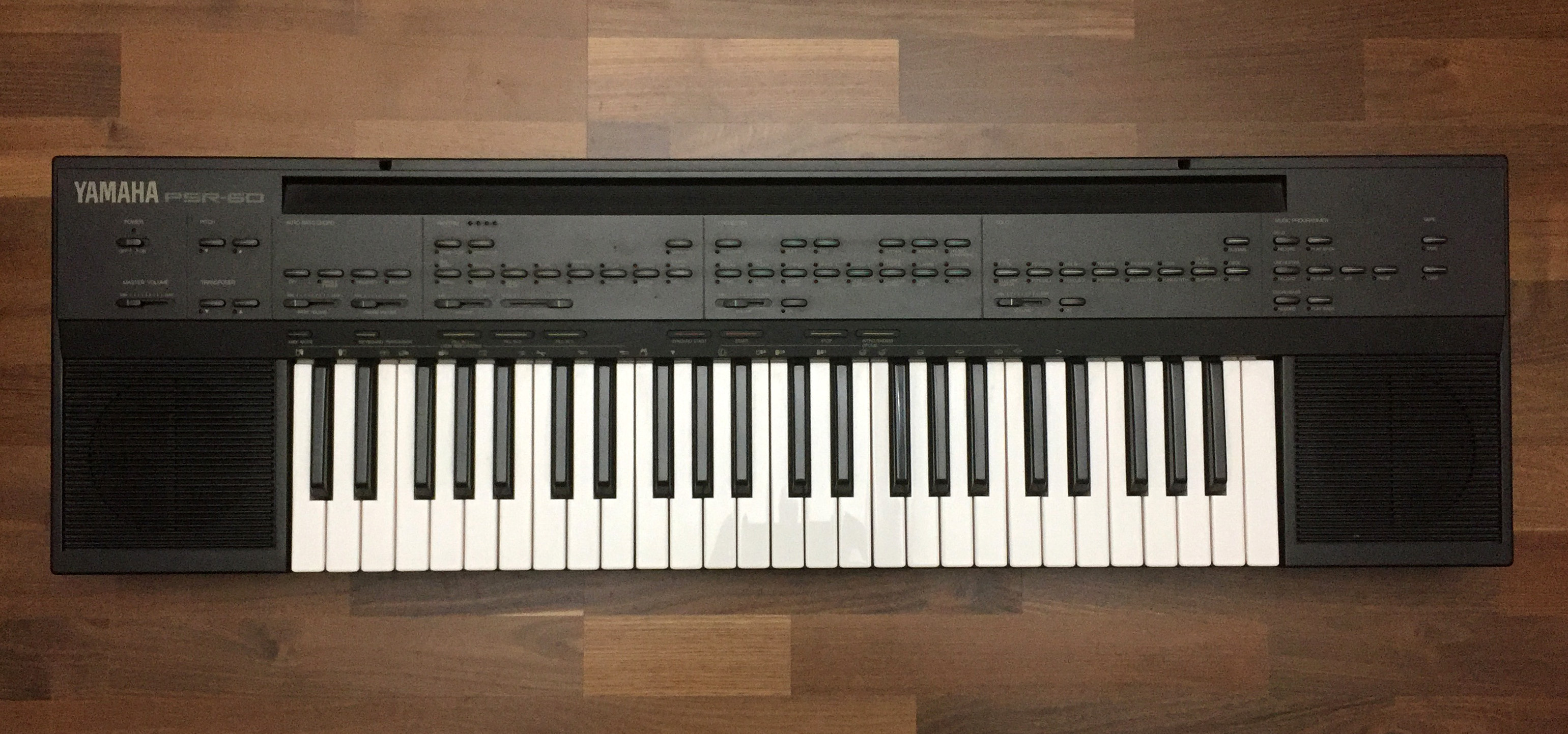
YAMAHA PSR-60
Similar to the PSR-47 the PSR-60 is a non-programmable FM keyboard - just with way less presets but also with MIDI. It also has a somewhat weird architecture with polyphonic and non-polyphonic as well as drum sounds which you can layer - you can probably also use it in a kind of multitimbral fashion - but I never tried that out.
The PSR-60 can be heard on
Cyberspace Database on the Void Gate Duology and of course on 'PSR-60' which wasn't recorded with the PSR-60 itself but with my PSR-60 sample pack.
Another device I sold in early 2019, to finance the
Cyberspace Database physical release.

KORG MONOTRON DELAY
It makes noises. Nothing groundbreaking but a fun little device to add some FX to your tracks.
Can be heard on
Cyberspace Database on the Void Gate Duology.
Also check the Cyberspace Database Project Documentation for more information about the audio gear used on Cyberspace Database as well as a complete synthesizer-per-track utilization list.
WORKSTATIONS (incomplete, sorted by relevance)

Mac Pro 5,1 (Late 2012 - 2 x 2.4 GHz 6-Core Xeon, 24 GB RAM)
Years in frequent use: 2013 - 2024
My main workstation between 2013 and 2024. Definitely no buyers remorse. Rock solid. Did render from AfterEffects and Blender at the same time, while also working in Cubase. Almost never crashed on me.
Acquired for use as video workstation, running 4 HDDs in RAID 0. Later dropped the RAID and switched to a SSD/HDD combination. Took over all DAW tasks from the MacBook Pro shown below in March 2019, after adding a UAD DSP card.
Mixing and mastering of Cyberspace Database, and the entire production of 'Music for dystopian concrete buildings: The future of Void Corp.' took place on this system.
Almost everything Fornax Void until spring 2024 was created on this system or went through it, one way or another.

MacBook Pro (Mid 2009)
Years in frequent use: 2009 - 2019
My main workstation between 2009 and 2012. Later on became my main recording DAW (running Cubase LE 6) for most of the tracks on Cyberspace Database. Was replaced as DAW by the MacPro shown above in March 2019.
While I'm not a fan of some of Apple's business practices, this system left a very good impression on me and actually still runs flawlessly 15 years later.
In some ways, the experience of using an Apple computer might have peaked around that time. The OS was rock solid, the hardware was slick, yet still somewhat serviceable and the Apple ecosystem bloat wasn't too extensive.

FRANKEN-PC
Years in frequent use: 2007/08 (?) - 2024
The exact origins of Franken-PC have become a mystery over the years, but the lore in the void scrolls says, I've built this system at some point before 2009.
The entirety of the album Memory Machine, as well as some tracks of Cyberspace Database (anything composed in FLStudio or Renoise) were produced on iterations / configurations of this PC. It also served as rendering workstation for a couple of the Cyberspace Database music videos.
Probably initially built as some sort of Wintel budget gaming rig, this is one of those systems that - after years of upgrades - doesn’t contain a single of it’s initial parts anymore. It first featured a Pentium D processor and later went through a couple of cheap AMD CPUs. At some point, I put a GTX1080 in there (bottlenecked by the budget CPU), for GPU 3D rendering and VR crap. I later replaced the case.
This is still my main system for anything running on Windows.
CAMERAS


Canon EOS 550D
The 550D (aka Kiss X4 / Rebel T2i) was one of the first affordable video-capable DSLR cameras - similar to the highly popular EOS 5D MKII but significantly less expensive. These types of cameras caused a little revolution back in the late 2000s / early 2010s and were an indie-filmmaker's dream come true. Got my first EOS550D back in 2010, but lost it on a trip to Tanzania in 2012. Acquired another one a few months later, which I'm still using to this day. Almost 15 years later, the specs are nothing to write home about, but it's still a solid photo camera and good enough video camera. The Magic Lantern firmware upgrade makes it pretty versatile.
Used this camera on the video clips for:
Oberheim Taxi / Shanghai Xpander
Affinity
Silts Mājas
and on other works...

Noname USB Stick Camera
I got this camera maybe 20 years ago from my Dad who bought it at some electronics market in China. It has no brand name or model number.
It does capture 1280x1024px JPEG files with lots of interesting noise and artifacts. When the internal 128 MB storage more than half full artifacts and glitches become abundant.
The camera can also capture Motion JPEG video in an OpenDML .AVI container with a resolution of 320x240px and a variable frame rate of approximately 5 to 12 fps.
I created an online gallery with pictures of this camera back in 2018:
USB Stick Camera Gallery

Pentax Zoom 70
Interesting late-80s autofocus camera with electronic / motorized zoom lens. Got that camera around 2012 in a thrift store and sold it in 2022.
A lot of the analog photographs made for
MFDCB:TFOVC were made with this camera.
There are also some photos of my 2012 chiptune setup on the
insights page that were made with the Zoom 70.
Overall a pretty nice everyday analog camera but uses a somewhat non-standard / annoying battery type and is pretty heavy and big for a snapshot cam.
Last update: 2024-Oct-27, 16:10 / 1730041810
Server time: 2025-Jun-27, 12:47:56 Europe/Zurich
Unix epoch time at last refresh: 1751021276
Swatch Internet Time at last refresh: 491
All content created by Fornax Void
(C) 1984-2025 Fornax Void, all rights reserved






































